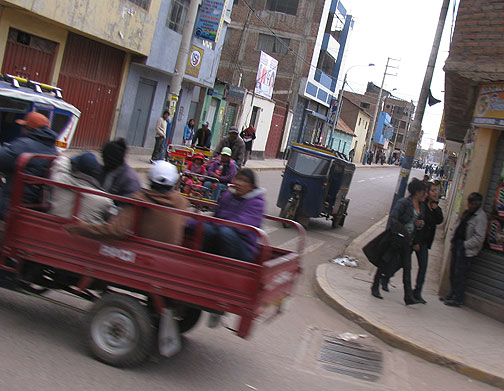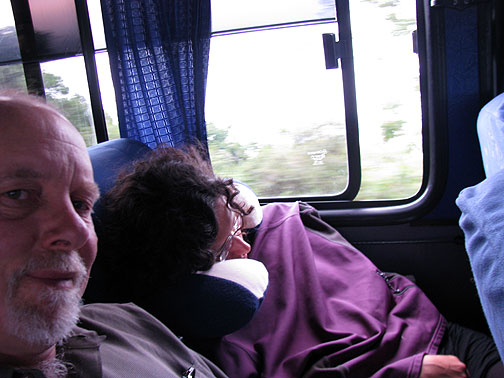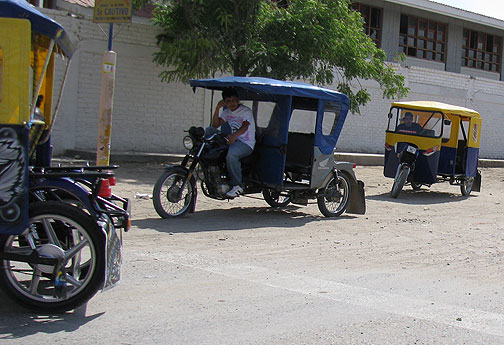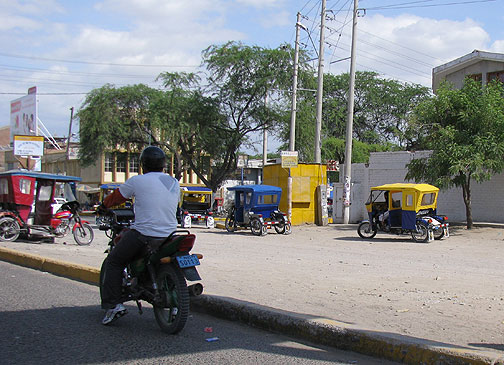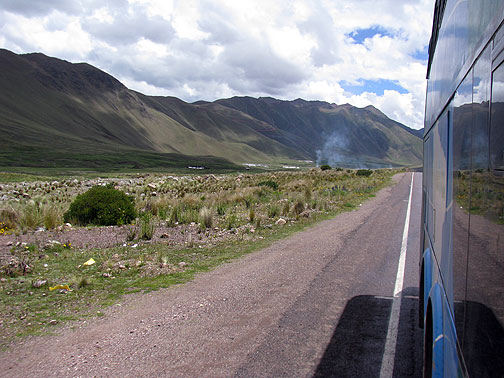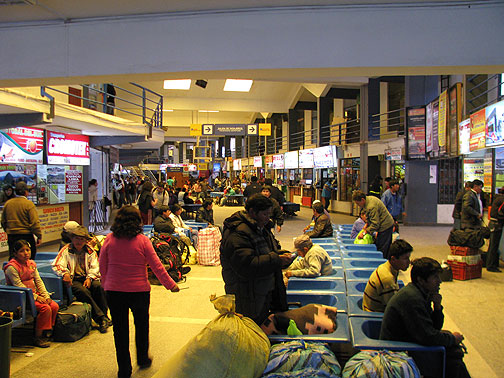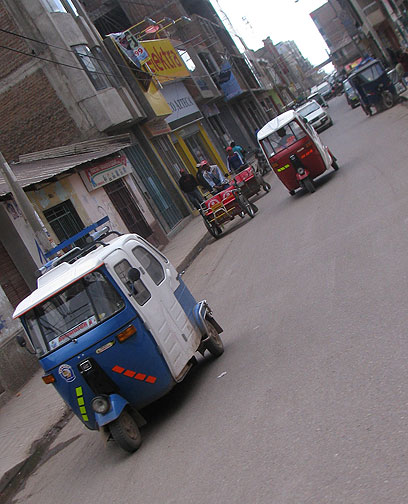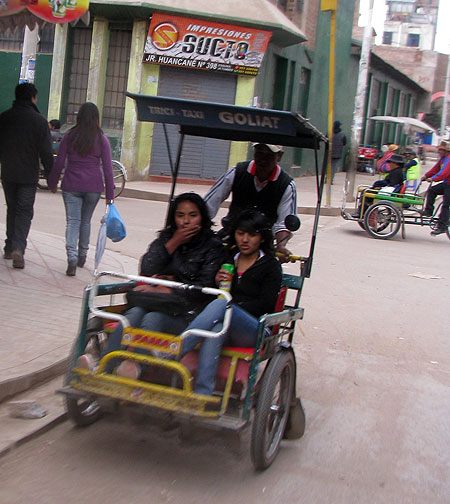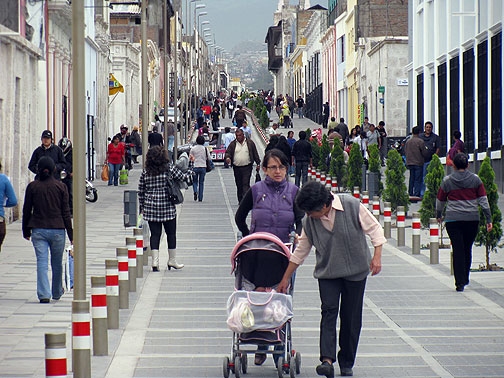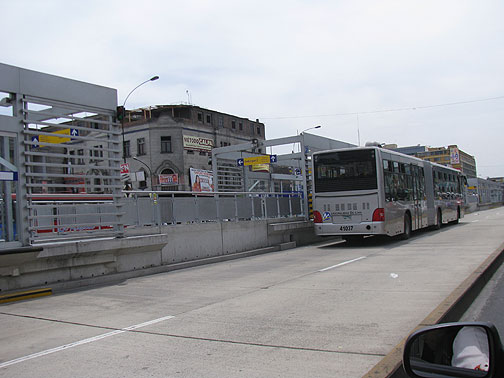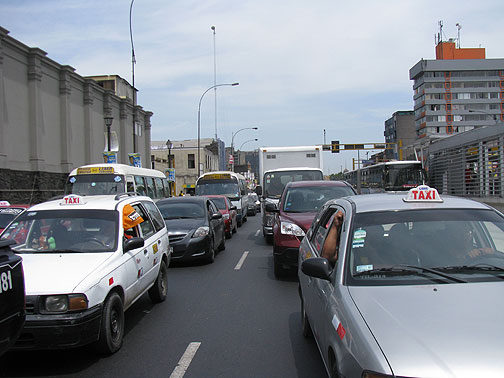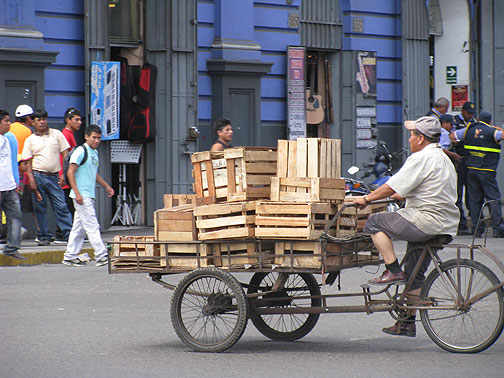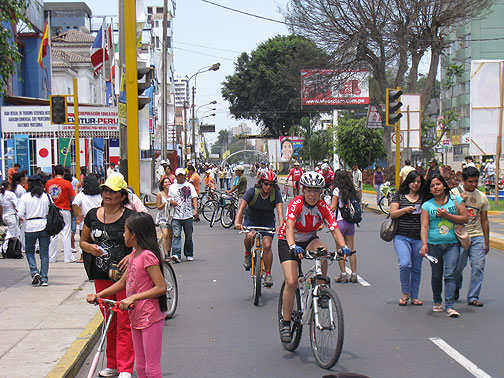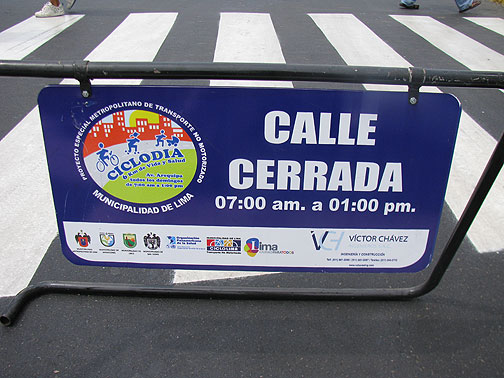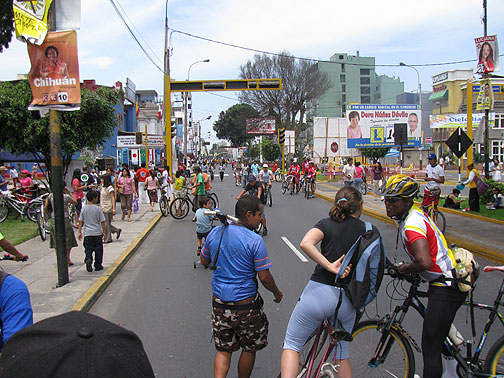Our daily urban lives shape our imaginations in so many ways. Few things box us in like our everyday transit options, and the patterns of traffic that shape our sense of public space. These patterns themselves are historical of course. A quick look back at the famous Market Street film shot a few days before the 1906 earthquake shows how chaotic and unpredictable the flow of traffic was when San Francisco's main artery hadn't yet been paved and standardized. Similarly, leaving the U.S. and visiting other countries provides a fantastic opportunity to experience other assumptions and possibilities for urban space, and surprisingly perhaps, a different range of vehicles.
In Peru for a couple of weeks I first had to adjust to a major cultural difference--unlike California, pedestrians don't have any legal rights, let alone cultural preference. When you start to cross the street at a corner in a Peruvian city, you better be ready to run. Because the cars are not going to wait for you, in fact they tend to speed up when they see someone trying to use the road space ahead of them. I noticed the same thing on highways too, a consistent refusal to yield to entering traffic, a universal assumption of individual ownership of the right of way. Here's a video below the break we shot standing on a traffic island in Peru's second largest city while waiting for the traffic to clear so we could cross the street.
We entered Peru on a bus from Ecuador, crossing the Macará river.
Bus travel was a big part of our journey in Peru, though we took a plane from Chiclayo on the north coast all the way to Cusco in the southern Andes. The beginning of our time in the country finished our descent from the Ecuadorian Andes to the stark desert of northern Peru. Our international bus arrived in the Peruvian city of Piura, which I hadn't heard of before, but it's a good-sized city of a half million or so, sitting amidst a heavily irrigated desert of citrus farms and more. The most surprising discovery as we rode in on the dusty streets was to see countless moto-taxis and freight tricycles. They outnumbered autos, filling the streets with the canopied three-wheelers.
We changed to another four-hour bus ride from Piura to Chiclayo where we grabbed a plane after a few hours of sleep in a hotel, having been on buses for about 22 hours. Once we made it to Cuzco we delighted in the ancient capital of the Incas. The incredible stone-masonry of the Inca culture is incomparable, and what a fun surprise to find one of the original streets of their capital still functioning. It's called Antisuyo and the massive granite blocks, so perfectly fit to each other, have survived centuries of earthquakes that crumbled lesser structures. The narrow, pedestrian friendly streets on the slopes of Cuzco are a walker's paradise.

From Cuzco we went on one of the world's famous "walks" on the Inca Trail. Four days, three mountain passes (the highest being 14,000 feet!), and a great deal of it on the thousands of original steps that make up the well-trodden Inca Trail. We learned a bit about the Inca Empire along our journey, and knew that their road system equalled the Romans in terms of engineering, management of water and drainage, and perhaps even sheer extent. Inca Trails extended from the capital in Cuzco all the way to Colombia in the north, Chile in the south, and encompassed a population of millions.
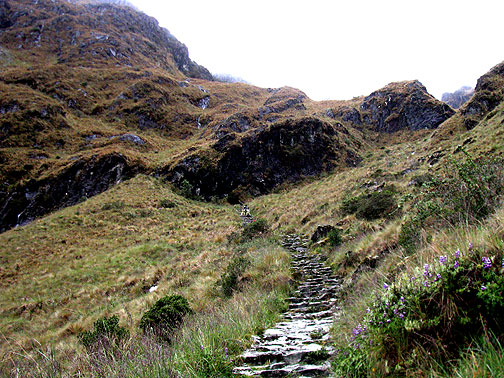
After an amazing four days that got us to Machu Picchu we caught a bus from Cuzco to Arequipa, but our "bed bus" was a broken down second-tier bus rather than the luxury ride we thought we were buying. The views of snow-capped mountains and endless green valleys in the Altiplano were stunning, and after about 8 hours we arrived in the high plains town of Juliaca. This town depended even more on pedicabs and freight bikes than we'd seen in the north.
We had a dramatic late dusk ride along the sides of a huge lake called Lagunillas, as rain and thunder engulfed us on the way to Arequipa. The city's night lights sprawled before us as we descended to it from the mountains. When we woke the next morning we realized we were still quite high (over a mile high) and in a surprisingly arid environment. Walking into downtown we found ourselves on Calle Bolivar, a pleasant pedestrian-centered avenue, which was a hint of something a little different in Peru's second largest city.
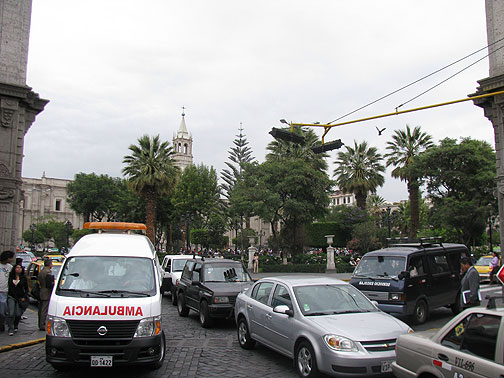
The historic city center's streets were jammed with taxis and combis, which we soon realized was normal in Peru's cities. Crossing the street was a continuous challenge but we started to get a handle on moving through the city (that video above captures the drama). We also found another street, Calle Mercaderos, which was closed to traffic and functioned like a long linear mall. In streets like this we see a different use of public space than we get normally in the U.S. Like the best European city centers, Peru too has taken important streets and dedicated them to pedestrians and public sauntering (and shopping of course).
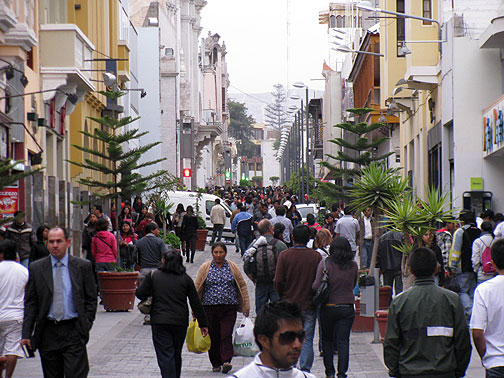
Finally we made our way to Lima, the country's capital. Traffic is insane in Lima, but the city won us over for lots of reasons. For one thing we stayed just off Avenida Arequipa, which happens to have a lovely center median that has a bike way or "ciclovia" running down the middle. We were staying with a friend and had fun learning to navigate Lima by way of the ubiquitous "combis," which come in all shapes and sizes and colors. The sing-song announcements of destination that the combi fare-takers used to help passengers decide which one to take was one of the pleasures of the ride. But the congested traffic, the bizarre competition between different combis to race ahead to get passengers at the next stop, and the generally aggressive driving by all vehicles presented an streetscape that was unmistakeably hostile to pedestrians.
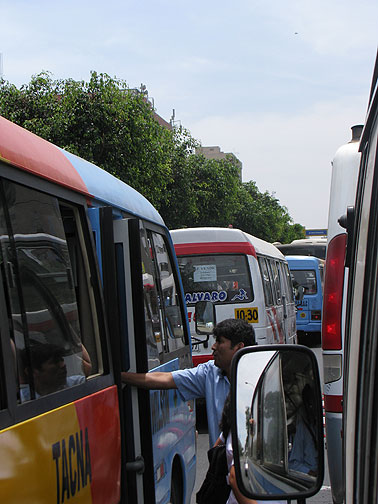
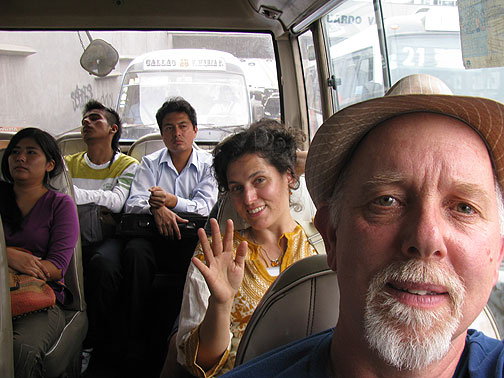
Lima is modernizing of course. They've put in a freeway that is locally known as "the Ditch," but down the middle of it is one of several Bus Rapid Transit lines called the Metropolitana. Here's a couple of shots of another Metropolitana line along one of the regular broad avenues in Lima.
We were hapy to connect with local cycling activists, who hosted me giving a Talk on cycling and Critical Mass history. Cicloaxion got a boost from the World Naked Bike Ride a few years back, and now there are several different cycling advocacy groups in town.
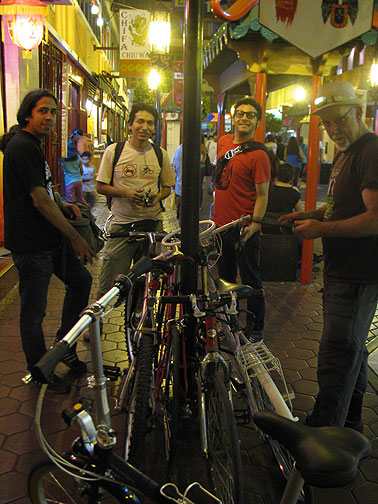
And ciclovias exist on a number of streets, along with barely used bicycle parking facilities.
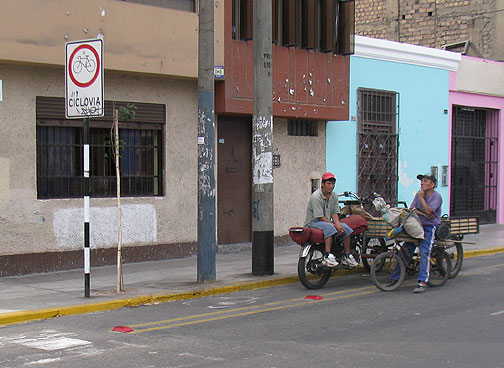
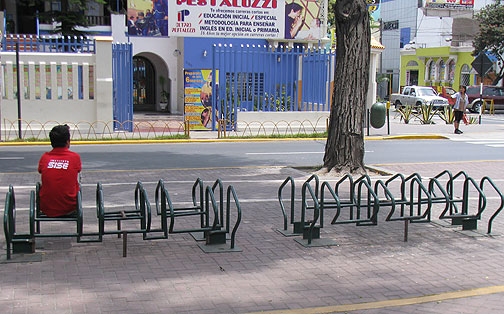
There are a lot of freight bikes rolling around Lima too.
Less than a month ago, Lima joined the growing world movement towards Sunday Streets with what they have dubbed "Ciclodia." Thousands of Lima cyclists and joggers get out on Sunday morning to enjoy a six-kilometer stretch closed to all traffic on Avenida Arequipa. It was great to wake up on Sunday morning to the silence, after having been wakened each of our previous days by the roar of combis and their horns jockeying for position on the same street. So Lima, and Peru more generally, present a panoply of street uses, and a veritable menagerie of vehicles! Nothing jogs or imaginations or our fantasies like immersion in other cultures and other possibilities.
Chris Carlsson will be giving one of his four-hour bicycle history tours on local transit history, this Sunday, April 3, from 12-4 pm. Meet at CounterPULSE, 1310 Mission at 9th at noon, bring water and snacks. (A $15-50 sliding scale donation is requested to benefit Shaping San Francisco.)
